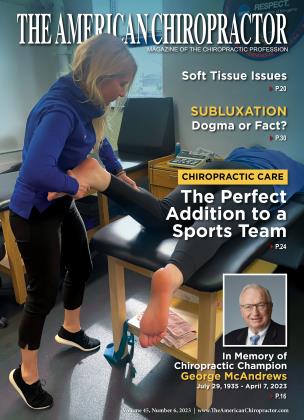Healthcare for the Generations to Come
CLINICAL EXCELLENCE
Mike Carberry
DC
As generations become pillars in our society, so do many of their cultural characteristics. We see this today with shopping, social media, and services — all our wants, needs, and interests are found in a one-stop sh-op. The ultimate convenience of easy access and all-in-one solutions has been a priority for younger generations. As chiropractors, what better way to attract this demographic than by offering a similar format for health care?
The medical integration model is perfectly equipped to service the younger generations. When it comes to health decisions, millennials and Gen Zs place a new value on accessibility, efficiency, quality service, and long-term health. Medical integration is designed to meet these needs by offering a one-stop shop for a range of healthcare services. By receiving multiple healthcare services in one location, it saves time and effort associated with scheduling multiple appointments and traveling to different providers. Even more so, with younger generations depending less on health insurance, the option of having cash-pay services is an attractive feature too.
By streamlining healthcare services and reducing the need for patients to visit multiple providers, medical integration can lead to shorter wait times, faster diagnosis and treatment, and better outcomes for patients. This is especially important for younger generations accustomed to instant gratification and value speed and efficiency.
With a medically integrated model in your chiropractic practice, you’re providing young patients with comprehensive and coordinated care. As the mindset shifts into prioritizing self-care and long-term health, this format becomes even more important. Younger generations are more likely to consider things such as preventative care and wellness rather than simply treating illness or injury. With the integration model, offices are well suited to meet these needs by offering a range of preventative services, such as chiropractic, physical therapy, and medical care.
Along with accessibility of service, there is also convenience of pay. The rise of cash-pay services has aided in attracting younger populations to medical integration. These generations may be more likely to opt for cashpay services rather than traditional insurance-based models because of their focus on transparency and affordability. This system of payment allows for simple deposits from the client to the office, which can be more appealing to not only younger generations but also for those who want to know what they’re paying up front.
Another trend to watch is the drive toward pharmaceutical alternative solutions for health and pain management. With social media accounts highlighting drug-free and holistic options for body health, integrated clinics offer the perfect balance of drug-free solutions and the trust of an MD in the office.
As the world continues to evolve to become more accessible and offer convenience, medical integration is prepared to fill this gap in health care. By offering a one-stop shop for a range of healthcare services, medical integration can meet the needs of younger generations who prioritize convenience and efficiency. With the addition of the feasibility of cash-pay services, medical integration is prepared to be the wave of the future of health care.
Mike Carberry, DC, is a Stockton University graduate and author of “The Death of American Healthcare”. He speaks nationally on an array of topics ranging from business, economics, and functional medicine’s role in fighting the opioid crisis. Co-founder of Advanced Medical Integration, his mission is to end the opioid crisis. AMI is offering live virtual events. To sign up visit: amidoctors.com.
 View Full Issue
View Full Issue









